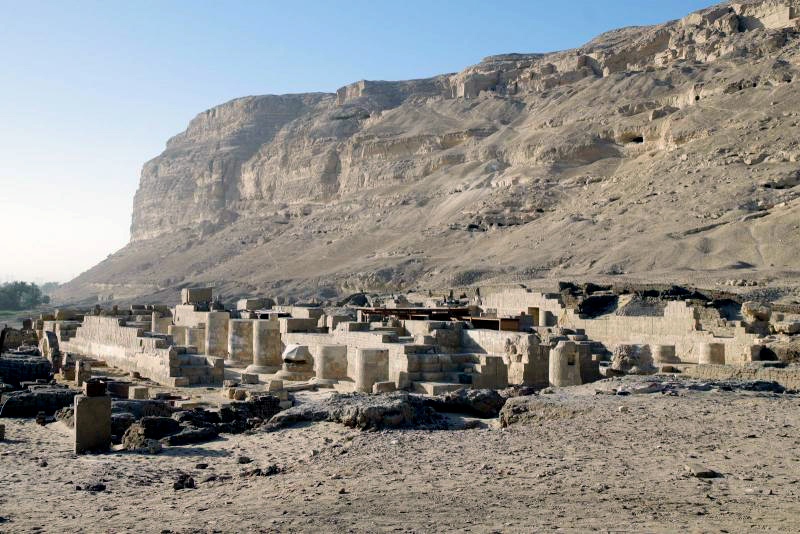The Women’s Monastery at Atripe
The site of Atripe has long been the reputed location for the late ancient women’s monastery associated with the monastic federation headed by Shenoute of Atripe.
Atripe, also known as Athribis,[1] is located at the village of Sheikh Hamad some 5 km to the south west of the modern city of Sohag. Its most prominent surviving feature is the Ptolemaic temple (fig. 1) dedicated to the goddess Repit. The temple of the goddess’s consort, Min, was located on the east bank of the Nile in the city of Akhmim (ancient Panopolis), the capital of the nome (i.e. province). Through the process of adaptive reuse, the temple later became a focus for Christian activities, but whether these were the remains of the women’s monastery in Shenoute’s federation, centered at the nearby White Monastery, has long been uncertain.[2]
The work of the Yale Monastic Archaeology Project (YMAP-South) at the site of Atripe has been motivated, at least in part, by a few important guiding questions. Do the remains there in fact belong to a monastery? If so, when was it active and what can the traces reveal about its history, organization, and gendered identity? The results of YMAP-South’s work have begun to provide answers to these questions. The site has now been verified as a late antique monastic foundation inhabited by female monastics and associated with Shenoute’s name and memory.
Figure 1. View of the temple complex looking south west.
YMAP-South Publications
A comprehensive archaeological volume on YMAP-South’s work at Atripe will be published by the Institut français d’archéologie orientale (IFAO) in Cairo. An article on the epigraphy has already appeared:
Davis, S. J. “Anastasia, Thecla, and Friends: Archaeological and Epigraphic Evidence from the Shenoutean Women’s Monastery at Atripe,” Le Muséon 133 (2020), 259–287.
Publication of an overview of YMAP-South’s recent work at Atripe and the White Monastery is expected in 2021:
Davis, Stephen J. “Archaeology at the Shenoutean Monastic Federation, 2010–2019: A Report on the Last Decade of YMAP’s Work,” Forthcoming in Coptica 19 (2020).
Further Reading
Abul-Yazid, M., S. Hammam, S. Abderrahman and A. el-Qadi. “Excavations in the Temple of Repit at Athribis in the 1980s.” In Athribis V. Archäologie im Repit-Tempel zu Athribis 2012–2016, ed. M. Müller, M. El-Bialy and M. Boriak, 427–436. Cairo: Institut français d’archéologie orientale, 2019.
Bock, W. de. Matériaux pour servir à l’archéologie de l’Égypte chrétienne. St. Petersburg, Eugène Thiele, 1901.
El-Masry, Y. “More Recent Excavations at Athribis in Upper Egypt,” Mitteilungen des Deutschen Archäologischen Instituts Abteilung Kairo 57 (2001), 205–218, pls. 29–31.
El-Sayed, R., and Y. El-Masry, eds. Athribis I, General Site Survey 2003–2007, Archaeological & Conservation Studies. The Gate of Ptolemy IX: Architecture and Inscriptions. 2 volumes. Cairo: Institut français d’archéologie orientale, 2012.
Krawiec, R. Shenoute and the Women of the White Monastery: Egyptian Monasticism in Late Antiquity. New York: Oxford University Press, 2002.
Layton, B. The Canons of Our Fathers: Monastic Rules of Shenoute. Oxford: Oxford University Press, 2014.
Layton, B. “Punishing the Nuns: A Reading of Shenoute’s Letters to the Nuns in Canons Book Four. In Christianity in Egypt: Literary Productions and Intellectual Trends. Studies in Honor of Tito Orlandi, ed. P. Buzi and A. Camplani, 325–345. Rome: Institutum Patristicum Augustinianum, 2011.
Layton, B. “Rules, Patterns, and the Exercise of Power in Shenoute’s Monastery: The Problem of World Replacement and Identity Maintenance,” Journal of Early Christian Studies 15 (2007), 45–73.
Layton, B. “Social Structure and Food Consumption in an Early Christian Monastery: The Evidence of Shenoute’s Canons and the White Monastery Federation A.D. 385–465,” Le Muséon 115 (2002), 25–55.
M. Müller, M. El-Bialy and M. Boriak, eds. Athribis V, Archäologie im Repit-Tempel zu Athribis 2012–2016. Cairo: Institut français d’archéologie orientale, 2019.
Petrie, W. M. F. Athribis. British School of Archaeology in Egypt and Egyptian Research Account 14. London: School of Archaeology in Egypt, 1908.
[1] The use of the place name “Athribis” in modern times to refer to this location is in fact a toponymic error, based on confusion generated by the similarity between the name Atripe and that of an ancient site named Athribis in the Egyptian Delta.
[2] For the women’s monastery, see: R. Krawiec, Shenoute and the Women of the White Monastery: Egyptian Monasticism in Late Antiquity (Oxford 2002); B. Layton, “Punishing the Nuns: A Reading of Shenoute’s Letters to the Nuns in Canons Book Four,” in Christianity in Egypt: Literary Productions and Intellectual Trends. Studies in Honor of Tito Orlandi, ed. P. Buzi and A. Camplani (Rome: Institutum Patristicum Augustinianum, 2011), 325–345.

